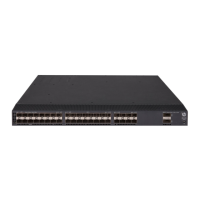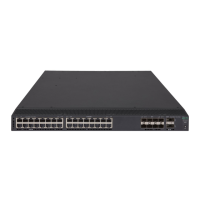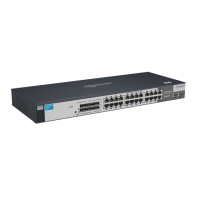89
Step Command Remarks
1. Enter system view.
system-view N/A
2. Enter Ethernet interface view.
interface interface-type
interface-number
N/A
3. Configure the 802.1X critical
VLAN on the port.
dot1x critical vlan vlan-id
By default, no 802.1X critical
VLAN is configured.
Specifying supported domain name delimiters
By default, the access device supports the at sign (@) as the delimiter. You can also configure the access
device to accommodate 802.1X users who use other domain name delimiters. The configurable
delimiters include the at sign (@), backslash (\), dot (.), and forward slash (/). Usernames that include
domain names can use the format of username@domain-name, domain-name\username,
username.domain-name, or username/domain-name.
If an 802.1X username string contains multiple configured delimiters, the rightmost delimiter is the
domain name delimiter. For example, if you configure the backslash (\), dot (.), and forward slash (/) as
delimiters, the domain name delimiter for the username string 121.123/22\@abc is the backslash (\).
The username is @abc and the domain name is 121.123 /22 .
If a username string contains none of the delimiters, the access device authenticates the user in the
mandatory or default ISP domain.
To specify a set of domain name delimiters:
Ste
Command
Remarks
1. Enter system view.
system-view N/A
2. Specify a set of domain name
delimiters for 802.1X users.
dot1x domain-delimiter string
By default, only the at sign (@)
delimiter is supported.
NOTE:
If you configure the access device to send usernames with domain names to the RADIUS server, make sure
the domain delimiter can be recognized by the RADIUS server. For username format configuration, see
the user-name-format command in
Security Command Reference
.
Configuring the EAD assistant feature
When you configure the EAD assistant feature, follow these restrictions and guidelines:
• You must disable MAC authentication and port security globally before you enable the EAD
assistant feature.
• To make the EAD assistant feature take effect on an 802.1X-enabled port, you must set the port
authorization mode to auto.
• When global MAC authentication or port security is enabled, the free IP does not take effect.
• If you use free IP, guest VLAN, and Auth-Fail VLAN features together, make sure the free IP segments
are in both guest VLAN and Auth-Fail VLAN.

